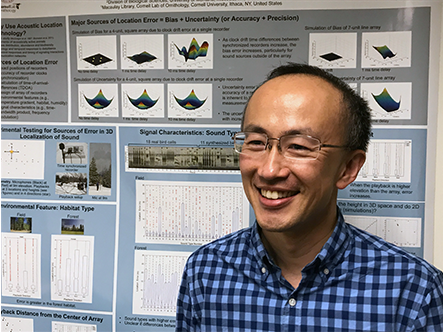Acoustics ’17 Boston
Observations from the 173rd meeting of the Acoustical Society of America, 25–29 June 2017
Holger, Aaron, Danielle, Bobbi, and I traveled to Boston, MA to attend the 173rd meeting of Acoustical Society of America. Three of us presented work on density estimation of animal populations using autonomous, underwater gliders and floats (Danielle), fish vocalization and ocean soundscapes (Aaron), and large-scale soundscape data analysis using unsupervised clustering techniques (myself).
We left very early morning on Sunday, June 25th and arrived in Boston at around noon. Six hours of quality time with my colleagues in the car. When we arrived at the convention center, it was a gigantic empty building and no one was there. It turns out that the conference took place in another convention center (Thanks Holger!), which is 30 min away in Boston’s Back Bay district.
Participating in conferences is both fun and exhausting. The working hours were between 7am and 10pm (sometimes longer depending on the company). Every morning we routinely checked the conference schedule and made decisions about which sessions and talks we would attend. At any given time, there were over 20 sessions going on simultaneously, distributed over two floors. Our primary interest is animal bioacoustics but we also occasionally sat in acoustic oceanography or signal processing sessions. The conference offered social events where we met our old friends and made new ones. There was not a single moment that was laid-back and relaxing: we were either listening to presentations or having intellectual conversations with colleagues.
My take-home messages from the conference:
The keyword “soundscape” was popular. There were six sessions with soundscape in their title, such as “Noise and Soundscapes in Restaurants and Other Public Accommodations” and “Archeo-Acoustics and Historical Soundscapes.” There were at least 60 presentations talking about soundscape.
There were a total of 15 animal bioacoustics sessions and quite often there were two animal bioacoustics sessions going on at the same time.
The fish bioacoustics session attracted a large enthusiastic crowd. There were two sessions back-to-back in one day. Aaron presented his work “Fish bioacoustics, big data, and changing ocean soundscapes” in this session and the talk was very well received.
Danielle presented her work “Evaluating autonomous underwater vehicles as platforms for animal population density estimation.” It is really a futuristic cutting-edge work: imagine a swimming robot, recording and detecting the sounds from whales and estimating the species’ population in a vast area. It’s like swimming with dolphins but in this case the one that swims is a robot, instead of human.
Bobbi participated in the conference as a graduate student. She is currently a master’s degree student in the Department of Natural Resources at Cornell University. She commented that there were so many interesting presentations at this ASA meeting and felt a bit overwhelmed:
Some talks that I attended focused on the impacts of underwater noise on marine species, noise reduction efforts, soundscapes, species population modeling, underwater vehicles, and big data analytics. One presentation that stood out for me was given by Joe Warren from Stony Brook University and focused on broadband, impulsive sounds in shallow water estuaries of New York. Many marine bioacousticians are quite familiar with the broadband sounds produced by snapping shrimp that can dominate the marine soundscape, however, there are, of course, several other biological culprits responsible for impulsive broadband sounds. Warren et al. presented audio and video evidence of scallops expelling jets of water, which aids in their movement along the seafloor, resulting in an impulsive broadband ‘cough’. Their movement across the ocean sediment was found to modify the acoustic properties of the ‘cough’. The team also recorded sounds of parrot fish eating seagrass, and sturgeons scraping their bodies on the seafloor. I found these data quite interesting, and it served as a good reminder that the marine biological soundscape is not only comprised of sounds of soniferous vertebrates, but includes invertebrate species that produce sound as a byproduct of their natural life activities.
I presented my work “Toward an unsupervised and automated analysis framework for large acoustic datasets to assess animal biodiversity and ecosystem health” in the session “Animal Bioacoustics: Ecosystem Acoustics II.” Presenting my talk was extremely challenging: I needed to satisfy both biologists and acousticians/engineers in the late afternoon (4:40pm) at the last day of the conference. Thus, I started my talk with blaming my co-authors for coming up with a very complicated title. I intentionally called out biologists to wake up and look at two beautiful figures. Stirring controversy was working, too. I questioned the validity of both automatic detection/classification and acoustic biodiversity indices techniques to analyze large multi-year acoustic datasets.
